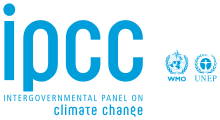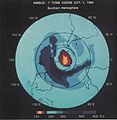Portal:Environment: Difference between revisions
m rw in purge link: "load new batch" |
No edit summary Tags: Reverted Mobile edit Mobile web edit |
||
Line 68:
|46=Renewable energy in Russia
|47=March for Science Portland
|49=Global Climate Coalition
|50=Wind power
Line 323 ⟶ 322:
{{/Things you can do}}
{{Box-footer}}
▲[[Category:Environment portal| ]]
| |||
Revision as of 00:24, 29 November 2021
Introduction The natural environment or natural world encompasses all biotic and abiotic things occurring naturally, meaning in this case not artificial. The term is most often applied to Earth or some parts of Earth. This environment encompasses the interaction of all living species, climate, weather and natural resources that affect human survival and economic activity. The concept of the natural environment can be distinguished as components:
In contrast to the natural environment is the built environment. Built environments are where humans have fundamentally transformed landscapes such as urban settings and agricultural land conversion, the natural environment is greatly changed into a simplified human environment. Even acts which seem less extreme, such as building a mud hut or a photovoltaic system in the desert, the modified environment becomes an artificial one. Though many animals build things to provide a better environment for themselves, they are not human, hence beaver dams, and the works of mound-building termites, are thought of as natural. People cannot find absolutely natural environments on Earth, and naturalness usually varies in a continuum, from 100% natural in one extreme to 0% natural in the other. The massive environmental changes of humanity in the Anthropocene have fundamentally effected all natural environments: including from climate change, biodiversity loss and pollution from plastic and other chemicals in the air and water. More precisely, we can consider the different aspects or components of an environment, and see that their degree of naturalness is not uniform. If, for instance, in an agricultural field, the mineralogic composition and the structure of its soil are similar to those of an undisturbed forest soil, but the structure is quite different. (Full article...)  The natural environment or natural world encompasses all biotic and abiotic things occurring naturally, meaning in this case not artificial. The term is most often applied to Earth or some parts of Earth. This environment encompasses the interaction of all living species, climate, weather and natural resources that affect human survival and economic activity. The concept of the natural environment can be distinguished as components:
In contrast to the natural environment is the built environment. Built environments are where humans have fundamentally transformed landscapes such as urban settings and agricultural land conversion, the natural environment is greatly changed into a simplified human environment. Even acts which seem less extreme, such as building a mud hut or a photovoltaic system in the desert, the modified environment becomes an artificial one. Though many animals build things to provide a better environment for themselves, they are not human, hence beaver dams, and the works of mound-building termites, are thought of as natural. People cannot find absolutely natural environments on Earth, and naturalness usually varies in a continuum, from 100% natural in one extreme to 0% natural in the other. The massive environmental changes of humanity in the Anthropocene have fundamentally effected all natural environments: including from climate change, biodiversity loss and pollution from plastic and other chemicals in the air and water. More precisely, we can consider the different aspects or components of an environment, and see that their degree of naturalness is not uniform. If, for instance, in an agricultural field, the mineralogic composition and the structure of its soil are similar to those of an undisturbed forest soil, but the structure is quite different. (Full article...) Selected article -Sustainability is a social goal for people to co-exist on Earth over a long time. Definitions of this term are disputed and have varied with literature, context, and time. Sustainability usually has three dimensions (or pillars): environmental, economic, and social. Many definitions emphasize the environmental dimension. This can include addressing key environmental problems, including climate change and biodiversity loss. The idea of sustainability can guide decisions at the global, national, and individual levels. A related concept is that of sustainable development, and the terms are often used to mean the same thing. UNESCO distinguishes the two like this: "Sustainability is often thought of as a long-term goal (i.e. a more sustainable world), while sustainable development refers to the many processes and pathways to achieve it." Details around the economic dimension of sustainability are controversial. Scholars have discussed this under the concept of weak and strong sustainability. For example, there will always be tension between the ideas of "welfare and prosperity for all" and environmental conservation, so trade-offs are necessary. It would be desirable to find ways that separate economic growth from harming the environment. This means using fewer resources per unit of output even while growing the economy. This reduces the environmental impact of economic growth, such as pollution. Doing this is difficult. Some experts say there is no evidence that it is happening at the required scale. (Full article...)Did you know -
Selected image - Nanotechnology refers broadly to a field of applied science and technology whose unifying theme is the control of matter on the molecular level in scales smaller than 1 micrometre, normally 1 to 100 nanometers, and the fabrication of devices within that size range. Nanopollution is the result of waste generated by nanotechnology and has implications on the wider environment. Current events
Selected biography - James B. Harkin (30 January 1875 – 27 January 1955), also known as the Father of National Parks, was a Canadian journalist turned bureaucrat with a passion for conservation but also widely renowned for his commodification of the Canadian landscape. Harkin began his career as a journalist under the umbrella of the Ottawa Journal and Montreal Herald, two conservative newspapers at the time, but soon through his persistence and prowess gained entry into civil service during his mid-twenties. Under the tutelage of some influential figures working for the Liberal Party of Canada, most notably Clifford Sifton and Frank Oliver, Harkin was able to acquire an appointment to be the first commissioner of the Dominion Parks Branch in 1911. During his career, Harkin oversaw the establishment of national parks that include Elk Island, Mount Revelstoke, Point Pelee, Kootenay, Wood Buffalo, Prince Albert, Riding Mountain, Georgian Bay Islands and Cape Breton Highlands. On a fundamental level, Harkin's philosophy had two dominant components: the economic, which saw park lands in commercial terms, and the humanitarian which saw parks as being integral to the well-being of the human spirit on a physical, mental and moral level. In successfully bringing these two principles together in a symbiotic way, Harkin was able to facilitate the incredible growth of Canadian tourism and, at the same time, justify his conservationist goals. (Full article...)Selected organization - The Intergovernmental Panel on Climate Change (IPCC) is an intergovernmental body of the United Nations. Its job is to advance scientific knowledge about climate change caused by human activities. The World Meteorological Organization (WMO) and the United Nations Environment Programme (UNEP) set up the IPCC in 1988. The United Nations endorsed the creation of the IPCC later that year. It has a secretariat in Geneva, Switzerland, hosted by the WMO. It has 195 member states who govern the IPCC. The member states elect a bureau of scientists to serve through an assessment cycle. A cycle is usually six to seven years. The bureau selects experts in their fields to prepare IPCC reports. There is a formal nomination process by governments and observer organizations to find these experts. The IPCC has three working groups and a task force, which carry out its scientific work. The IPCC informs governments about the state of knowledge of climate change. It does this by examining all the relevant scientific literature on the subject. This includes the natural, economic and social impacts and risks. It also covers possible response options. The IPCC does not conduct its own original research. It aims to be objective and comprehensive. Thousands of scientists and other experts volunteer to review the publications. They compile key findings into "Assessment Reports" for policymakers and the general public; Experts have described this work as the biggest peer review process in the scientific community. (Full article...)General images -The following are images from various environment-related articles on Wikipedia.
Selected quote -Main topicsRelated articlesThings you can do
|












































